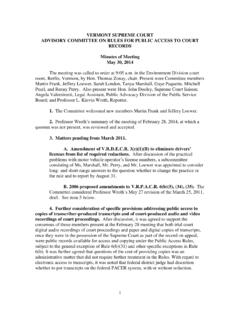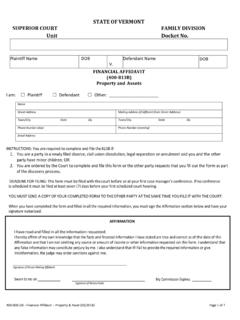Transcription of VERMONT RULES OF PROFESSIONAL CONDUCT
1 VERMONT RULES OF PROFESSIONAL CONDUCT . I. Preamble and Scope Preamble: A Lawyer's Responsibilities RULES . Terminology. CLIENT-LAWYER RELATIONSHIP. Competence. Scope of Representation and Allocation of Authority Between Client and Lawyer. Diligence. Communication. Fees. Confidentiality of Information. Conflict of Interest: Current Clients. Conflict of Interest: Current Clients: Specific RULES . Duties to Former Clients. Imputation of Conflicts of Interest: General Rule. Special Conflicts of Interest for Former and Current Government Officers and Employees. Former Judge, Arbitrator, Mediator or Other Third-Party Neutral. Organization as Client. Client with Diminished Capacity. Safekeeping Property. Trust Accounting System. Pooled Interest-Bearing Trust Accounts. [Repealed.]. Declining or Terminating Representation. Sale of Law Practice. Duties to Prospective Client. COUNSELOR. Advisor. [Repealed.]. Evaluation for Use by Third Persons. Lawyer Serving as Third-Party Neutral. ADVOCATE.
2 Meritorious Claims and Contentions. Expediting Litigation. Candor Toward the Tribunal. Fairness to Opposing Party and Counsel. Impartiality and Decorum of the Tribunal. Trial Publicity. Lawyer as Witness. Special Responsibilities of a Prosecutor. Advocate in Nonadjudicative Proceedings. 1. TRANSACTIONS WITH PERSONS OTHER THAN CLIENTS. Truthfulness in Statements to Others. Communication with Person Represented by Counsel. Dealing with Unrepresented Person. Respect for Rights of Third Persons. Threatening Criminal Prosecution. LAW FIRMS AND ASSOCIATIONS. Responsibilities of Partners, Managers, and Supervisory lawyers . Responsibilities of a Subordinate Lawyer. Responsibilities Regarding Nonlawyer Assistants. PROFESSIONAL Independence of a Lawyer. Unauthorized Practice of Law; Multijurisdictional Practice of Law. Restrictions on Right to Practice. Responsibilities Regarding Law-Related Services. PUBLIC SERVICE. Voluntary Pro Bono Publico Service. Accepting Appointments. Membership in Legal Services Organization.
3 Law Reform Activities Affecting Client Interests. Nonprofit And Court-Annexed Limited Legal Services Programs. INFORMATION ABOUT LEGAL SERVICES. Communications Concerning a Lawyer's Services. Advertising. Direct Contact With Prospective Clients. Communication of Fields of Practice and Specialization. Firm Names and Letterheads. Political Contributions to Obtain Government Legal Engagements or Appointments by Judges. MAINTAINING THE INTEGRITY OF THE PROFESSION. Bar Admission and Disciplinary Matters. Judicial and Legal Officials. Reporting PROFESSIONAL Misconduct. Misconduct. Disciplinary Authority; Choice of Law. HISTORY. History. These RULES replace the VERMONT Code of PROFESSIONAL Responsibility, adopted by the Court on February 10, 1971, and amended thereafter. These RULES apply to lawyer CONDUCT after September 1, 1999. The Code of PROFESSIONAL Responsibility continues to apply to CONDUCT prior to September 1, 1999. These RULES were adopted by Supreme Court Order dated March 9, 1999.
4 Introductory Reporter's Note 2009 Amendments The VERMONT RULES of PROFESSIONAL CONDUCT are amended to incorporate comprehensive and significant changes to the American Bar Association's Model RULES of PROFESSIONAL CONDUCT that were adopted by the ABA. House of Delegates in 2001-2003. 2. The changes to the Model RULES were initially proposed by the ABA's Commission on the Evaluation of the RULES of PROFESSIONAL CONDUCT (the Ethics 2000'' Commission) established by the Board of Governors in 1997 to CONDUCT the first comprehensive review of the Model RULES since their initial adoption in 1983. The review was designed to address the lack of uniformity in state adoptions of the Model RULES , as well as the rapidly changing climate of the practice of law produced by the impact of technology and the changing dynamic of the legal profession. The Commission sought to produce amendments within the existing framework of the Model RULES that would be a balanced blend of traditional precepts and forward-looking provisions that are responsive to modern developments.
5 '' Chair's Introduction, ABA Model RULES of PROFESSIONAL CONDUCT (2002). Those modern developments'' included the promulgation in 1998 of the American Law Institute's Restatement of the Law Governing lawyers , a comprehensive statement and analysis of the entire legal framework governing the legal profession and the practice of law that can serve as a guide to understanding and application of the principles underlying the Model RULES . The present amendments to the VERMONT RULES were recommended by the Supreme Court's Advisory Committee on RULES of Civil Procedure. They include amendments to the Model RULES proposed by the Ethics 2000. Commission and adopted by the House of Delegates in August 2001 and February 2002 with a number of further amendments. The present VERMONT amendments also include additional amendments to Model RULES and proposed by the ABA Standing Committee on Ethics and PROFESSIONAL Responsibility, and to Model RULES and , proposed by the ABA Commission on Multijurisdictional Practice, adopted in August 2002.
6 Included also are further amendments to Model RULES and proposed by the ABA Task Force on Corporate Responsibility and the Standing Committee on Ethics and PROFESSIONAL Responsibility and adopted in August 2003. The present VERMONT amendments do not include subsequent amendments to Model RULES Comment (2007), (2008), Comment (2009), and (2009) because they have not yet been reviewed by the Advisory Committee. The VERMONT Supreme Court adopted the VERMONT RULES of PROFESSIONAL CONDUCT by order of March 9, 1999, effective September 1, 1999, in order to provide standards for lawyer CONDUCT that reflected current national trends in the field and offered substantial uniformity with most other states as well as ready access to their decisions on key issues. Thus, the VERMONT RULES in large measure incorporated the language and form of the ABA. Model RULES and amendments to them that had been adopted prior to the adoption of the VERMONT RULES . In a few areas, however, the VERMONT RULES differed from the Model RULES , either to preserve an existing VERMONT rule or practice or because the ABA rule had proven unsatisfactory in other jurisdictions.
7 The Reporter's Notes to the VERMONT RULES as promulgated in 1999 highlight those differences. Because uniformity with the national model remains an important goal, the present VERMONT amendments incorporate virtually all of the 2001-2003 ABA. amendments. Nevertheless, most of the distinctive VERMONT variations adopted in 1999 have been retained in the present amendments, and those amendments also differ in specific respects from the amended Model RULES where VERMONT practice calls for a different approach. The Reporter's Notes to the present amendments point out and explain these differences. The basic goal of national uniformity is well on the way to attainment, but state variations persist. As of May 14, 2009, 40 states and the District of Columbia had adopted amended RULES based on the ABA amendments with many individual variations; in an additional seven states (including VERMONT ) review committees had published revised RULES for consideration, also with variations; in the remaining three states, committee review was under way.
8 See Charlotte K. Stretch and Susan M. Campbell, State Committees Review and Respond to Model RULES Amendments, 15 No. 1 Prof. Law. 14 (2004, updated November 30, 2007), available at , where the principal variations are summarized. Links to detailed charts maintained by the ABA Center for PROFESSIONAL Responsibility Policy Implementation Committee showing the current status of state adoptions and variations may be found on the Center's website at In sum, the amended Model RULES continue to provide a basic framework common to all states that have adopted them, but there are significant variations among those state RULES in particular details. The present text consists of the amended RULES themselves, the amended ABA Comments on each rule (also adapted to VERMONT differences), and Reporter's Notes designed to explain the reasons for which the Model RULES were changed, as well as the basis for any VERMONT variations. For uniformity and ease of reference, the amendments adopt the paragraph numbering system of the ABA Comments throughout.
9 As with the 1999. promulgation of the VERMONT RULES , the Comments are intended as guides to interpretation, but the text of each Rule is authoritative.'' See Scope,'' below. In preparing the Reporter's Notes, the Reporter has drawn heavily upon the Ethics 2000 Commission's Reporter's Explanation of Changes to Model RULES ,'' prepared by Reporters Nancy J. Moore, Thomas D. Morgan, and Carl A. Pierce, available at (hereinafter ABA Reporter's Explanation). Where the ABA Reporter's Explanation does not reflect VERMONT variations, differences are noted in bracketed insertions. The current Reporter's Notes should be read in conjunction with the Reporter's Notes that accompanied the 1999 promulgation and with the principal VERMONT Supreme Court cases applying the VERMONT RULES since 1999 that have been cited in the current Notes. As always, 3. the Reporter's Notes are advisory. For additional interpretive guidance, see ABA Center for PROFESSIONAL Responsibility, Annotated Model RULES of PROFESSIONAL CONDUCT (6th ed.)
10 2007 and subsequent editions);. ABA/BNA, lawyers ' manual on PROFESSIONAL CONDUCT (1984-date); American Law Institute, Restatement of the Law: The Law Governing lawyers (2000, and annual supps. to date). The Advisory Committee was asked by the Supreme Court in 2003 to undertake a full review of the 2001- 2003 Model RULES amendments and to make recommendations concerning their adoption for VERMONT . To CONDUCT its review, the Committee appointed a subcommittee consisting of Committee Chair William E. Griffin and members Joseph E. Frank and Jean Brewster Giddings, and the following distinguished members of the VERMONT Bar: former ABA Delegate Richard T. Cassidy, former Judicial CONDUCT Board Chair Christopher L. Davis, and VERMONT Bar Association PROFESSIONAL Responsibility Committee Chair Sheila M. Ware. The subcommittee had the advice and assistance of Wendy Collins, Bar Counsel to the PROFESSIONAL Responsibility Program, and the undersigned, Reporter to the Advisory Committee.









